

Picture album

The desk where Queen Victoria signed her assent to the document creating the Commonwealth of Australia on 9 July 1900 was the centrepiece of the first Commonwealth ceremony in Sydney's Centennial Park on 1 January 1901. Here the first Governor-General takes his oath of office at the desk.
Location: National Archives of Australia [A1200, L83907]
Related documents

The grand ceremony of the opening of the Commonwealth Parliament, on 9 May 1901, was held in Melbourne's Exhibition Building. The Commonwealth Parliament continued to sit in Melbourne as the site of the national capital was not decided until 1909 and the first Parliament House was not completed until 1927.
Location: National Archives of Australia [A6180, 4/3/77/5]
Related documents

Edmund Barton, Australia's first Prime Minister, is seated second from the left, surrounded by the Federal Executive Council, comprising his Cabinet ministers and the Governor-General, Lord Tennyson. Standing, left to right are JG Drake, Senator Richard O'Connor, Sir Phillip Fysh, Charles Kingston, and Sir John Forrest. Seated, left to right are Sir William Lyne, Edmund Barton, Lord Tennyson, Alfred Deakin, and Sir George Turner.
Location: National Archives of Australia [A1200, L13365]

Photographed at the first sitting of the High Court at the Supreme Court of Victoria on 6 October 1903, the first three judges of the High Court of Australia are (seated, left to right ): Edmund Barton, Sir Samuel Griffith and Richard O'Connor, with Court officials standing behind.
Location: National Archives of Australia [A12340]
Related documents

The Governor-General, Lord Denman, arriving at Capital Hill, Canberra, for the foundation ceremony of the national capital on 12 March 1913.
Location: National Archives of Australia [A1200, L16933]
Related documents
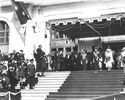
Prime Minister Stanley Melbourne Bruce speaking at the opening of the first Parliament House, Canberra on 9 May 1927, with the Duke and Duchess of York at the head of the stairs.
Location: National Archives of Australia [A6180, 20/5/74/42]

A citizenship ceremony of the 1950s, complete with a portrait of Queen Elizabeth II between the Australian and British flags, citizenship certificates also featuring an image of the Queen, and presentation eucalypt seedlings. These symbols show that Australian citizens were also British subjects from the passage of the Citizenship Act 1949 until an amendment in 1973.
Location: National Archives of Australia [B580, 4]
Related documents

Three Northern Territorians who become Australians at a citizenship ceremony at the Alice Springs Bang Tail Muster in 1959 are congratulated by Jock Nelson, Member of the House of Representatives for the Northern Territory.
Location: National Archives of Australia [A1200, L30949]
Related documents

During the Royal Tour in 1954 Queen Elizabeth II signed her assent to the Flags Act 1953 which defined the Australian flag – but in the crowds greeting the Royal couple, the Australian flag is overwhelmed by the British Union Jack.
Location: National Archives of Australia [A1773, RV1283]
Related documents

Sir Isaac Isaacs became the first Australian-born Governor-General, when Prime Minister James Scullin insisted on making the recommendation to the King.
Location: National Archives of Australia [A1200, L8925]
Related documents
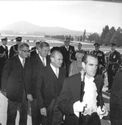
The Usher of the Black Rod leads the official party into Parliament House for the ceremony installing Sir Paul Hasluck as Governor-General in 1969. Prime Minister John Gorton is third in line, behind the new Governor-General.
Location: National Archives of Australia [A1200, L80915]
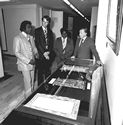
Yolngu leaders Gallarwuy Yunupingu (left) and Silas Roberts at Parliament House in 1977 with Jeremy Long and the Minister for Aboriginal Affairs, Ian Viner (right), looking at the two bark petitions presented to the House of Representatives in 1963. These petitions are displayed in the glass case with a 1968 petition and message stick, also presented by the people of Yirrkala in the Northern Territory.
Location: National Archives of Australia [A8739, A11/3/77/3]
Related documents
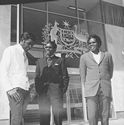
In 1968, after their petitions to Parliament failed to gain recognition of their rights to land, Yolngu people from Yirrkala in eastern Arnhem Land took their case to the Northern Territory Supreme Court. The leaders in this action, known as the Gove Land Rights Case, are pictured in Canberra in September 1970, outside the ACT Supreme Court building. The High Court met there in Canberra for a ruling on the case, decided by the Northen Territory Supreme Court in 1971.
Location: National Archives of Australia [A1200, L88864]
Related documents

After the failure of the Gove Land Rights Case in 1971, public attention to the legal problems of Indigenous people increased and so did campaigns for change to the law. Here, Aboriginal people and supporters demonstrate at Parliament House in 1974.
Location: National Archives of Australia [A6135, K5/3/74/10]
Related documents

On Australia Day 1972 Aboriginal people set up a tent embassy on the lawns in front of Parliament House. The embassy was removed by police and re-established several times until February 1975, when it closed. The following year Parliament passed the first Commonwealth law on land rights. A second tent embassy, opened on the same site in January 1992 while the High Court was deciding the Mabo Case, still stands in front of the first Parliament House.
Location: National Archives of Australia [A6135, K14/3/74/11]
Related documents
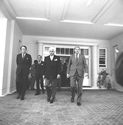
Prime Minister Malcolm Fraser, Governor-General Sir John Kerr and Deputy Prime Minister Doug Anthony leave Government House after the swearing-in of Ministers in the new Government, following the double dissolution of the Commonwealth Parliament in November 1975.
Location: National Archives of Australia [A6180, 13/11/75/1]

The Governor-General's role in dissolving the Parliament and ending the Government of Gough Whitlam in November 1975 caused widespread demonstrations, challenging his authority under the Constitution to dismiss an elected government. Here hundreds of protestors are gathered in front of Parliament House.
Location: National Archives of Australia [A6135, K14/11/75/39]
Related documents

The new building in Canberra for the High Court of Australia was completed on the southern shore of Lake Burley Griffin in 1980.
Location: National Archives of Australia [A8746, KN24/3/80/8]
Related documents

Queen Elizabeth II signs the Proclamation of the Australia Act on 2 March 1986 at Government House, Canberra, with David Reid, Secretary to the Executive Council (left) and Prime Minister Bob Hawke.
Location: National Archives of Australia [A8746, KN18/3/86/33]
Related documents

Eddie Mabo (left) at home on the island of Mer in the Torres Strait Islands during the High Court hearings in the Mabo Case, which eventually recognised Indigenous people's title to their lands.
Location: National Archives of Australia [A6180, 9/3/94/23]
Related documents